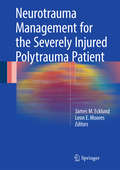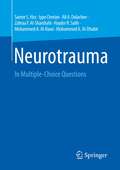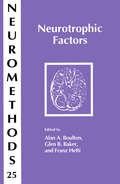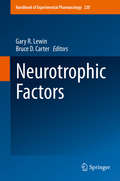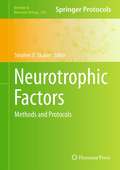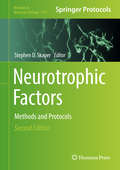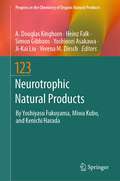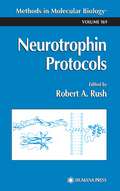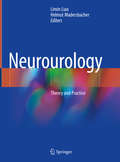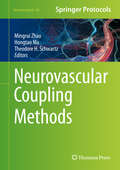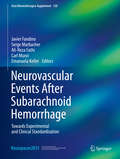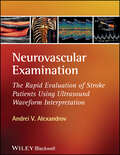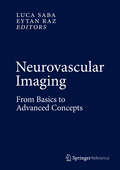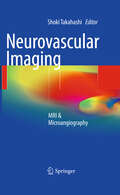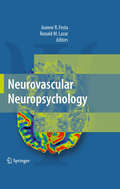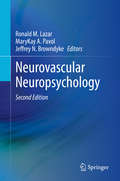- Table View
- List View
Neurotrauma Management for the Severely Injured Polytrauma Patient
by James M. Ecklund Leon E. MooresThis text addresses many of the questions which occur when medical professionals of various disciplines interact and have different plans and interventions, each with its own valid scientific and/or experience-based rationale: Questions involving tourniquet placement, ideal fluids and volumes for resuscitation, VTE prophylaxis and many other management considerations. Straightforward decisions in the patient with a single diagnosis often conflict when applied to the neurologically injured polytrauma patients. Neurotrauma Management for the Severely Injured Polytrauma Patient answers as many of these questions as possible based on the current literature, vast experience with severe neurotrauma in the current conflicts in Afghanistan and Iraq, and the experience of trauma experts across the globe as well as proposes areas for future study where answers are currently less clear.
Neurotrauma: In Multiple-Choice Questions
by Samer S. Hoz Ali A. Dolachee Hayder R. Salih Iype Cherian Zahraa F. Al-Sharshahi Mohammed A. Al-Rawi Mohammed A. Al-DhahirNeurotrauma in Multiple Choice Questions is the FIRST review book to use the multiple-choice question format in neurosurgical trauma. Students of neurosurgery, the resident, the fellow, the younger neurosurgeon preparing for exams or practice, and even the later stage neurosurgeon are the target audience of this book. The information in this work is in accordance with the most up-to-date best practice evidence, with a style that mirrors the format adopted by the majority of local, regional, and international board examinations. The strategy and format of the questions provide a stepwise progression from definition to surgical decision-making, to a comprehensive and concise overview of neurological trauma.
Neurotrophic Factors
by Alan A. Boulton Glen B. Baker Franz HeftiLeading researchers present those techniques that have been crucial to propelling the neurotrophic factors field to its current state of high visibility. The techniques range from molecular biological methods used for cloning and production, to cell culture methods for assessing biological activities, to animal models of nervous system injury (necessary for the development of therapeutic agents from neurotrophic factors).
Neurotrophic Factors
by Gary R. Lewin Bruce D. CarterThis book provides critical reviews of the role of neurotrophins and their receptors in a wide variety of diseases including neurodegenerative diseases like Huntington's syndrome, cognitive function, psychiatric disorders such as clinical depression, Rett syndrome, motoneurone disease, spinal cord injury, pain, metabolic disease and cardiovascular disease. It also contains contributions from leaders in the field dealing with the basic biology, transcriptional and post-translational regulation of the neurotrophins and their receptors. The present book will review all recent areas of progress in the study of neurotrophins and their biological roles.
Neurotrophic Factors
by Stephen D SkaperNervous system development evolves from the well-orchestrated processes of neural induction, cell proliferation, differentiation, cell migration, survival, and synapse formation. Among these environmental cues, neurotrophic factors are secreted proteins that promote neurite outgrowth, neuronal cell differentiation and survival both in vivo and in vitro. Nerve growth factor (NGF) is the founding and best characterized member of the neurotrophin family of neurotrophic polypeptides. Neurotrophic Factors: Methods and Protocols presents a selection of protocols and procedures which make use of cellular, tissue, and whole animal models which can be applied to the investigation of neurotrophic factors and other agents impacting on these systems. Chapters cover a wide-range of topics such as dealing with the culture of neurons and glia from the central and peripheral nervous systems, neuron-glia co-culture models, and cell-based assays for the evaluation of neuroprotective molecules, as well as assays which can be applied to the study of agents with neuroregenerative potential. Protocols describing viral- and nanoparticle-based delivery methods to neural cells are also presented, following by chapters dealing with organotypic slice culture protocols. Lastly, several chapters are dedicated to in vivo lesion models of relevance to nervous system pathology, which can be applied to the investigation of neurotrophic factors and peptides. Written in the successful Methods in Molecular BiologyTM series format, chapters include introductions to their respective topics, lists of the necessary materials and reagents, step-by-step, readily reproducible protocols, and notes on troubleshooting and avoiding known pitfalls. Authoritative and easily accessible, Neurotrophic Factors: Methods and Protocols seeks to serve both professionals and novices alike with its well-honed methodologies in an effort to further our knowledge of what has been described as the last frontier of science.
Neurotrophic Factors
by Stephen D. SkaperNervous system development evolves from the well-orchestrated processes of neural induction, cell proliferation, differentiation, cell migration, survival, and synapse formation. Among these environmental cues, neurotrophic factors are secreted proteins that promote neurite outgrowth, neuronal cell differentiation and survival both in vivo and in vitro. Nerve growth factor (NGF) is the founding and best characterized member of the neurotrophin family of neurotrophic polypeptides. Neurotrophic Factors: Methods and Protocols presents a selection of protocols and procedures which make use of cellular, tissue, and whole animal models which can be applied to the investigation of neurotrophic factors and other agents impacting on these systems. Chapters cover a wide-range of topics such as dealing with the culture of neurons and glia from the central and peripheral nervous systems, neuron-glia co-culture models, and cell-based assays for the evaluation of neuroprotective molecules, as well as assays which can be applied to the study of agents with neuroregenerative potential. Protocols describing viral- and nanoparticle-based delivery methods to neural cells are also presented, following by chapters dealing with organotypic slice culture protocols. Lastly, several chapters are dedicated to in vivo lesion models of relevance to nervous system pathology, which can be applied to the investigation of neurotrophic factors and peptides. Written in the successful Methods in Molecular Biology(tm) series format, chapters include introductions to their respective topics, lists of the necessary materials and reagents, step-by-step, readily reproducible protocols, and notes on troubleshooting and avoiding known pitfalls. Authoritative and easily accessible, Neurotrophic Factors: Methods and Protocols seeks to serve both professionals and novices alike with its well-honed methodologies in an effort to further our knowledge of what has been described as the last frontier of science.
Neurotrophic Natural Products (Progress in the Chemistry of Organic Natural Products #123)
by A. Douglas Kinghorn Heinz Falk Simon Gibbons Yoshinori Asakawa Ji-Kai Liu Verena M. DirschThis book deals with neurotrophins (NGF, BDNF, NT3, NT4), which can decrease cell death, induce differentiation, as well as sustain the structure and function of neurons. This makes neurotrophins potential therapeutic agents for the treatment of neurodegenerative disorders. However, these proteins have so far been ineffective in clinical trials mostly because they cannot pass the blood-brain barrier owing to their high-molecular weights. Consequently, small molecules that mimic neurotrophins and stimulate the synthesis of endogenous neurotrophins or enhance their neurotrophic actions are expected to be promising alternatives. Small-molecule natural products, which have been used in dietary functional foods or in traditional medicine over the course of human history, have potential to be developed as new therapeutic agents against neurodegenerative conditions such as Alzheimer’s disease. In this book, the authors introduce a variety of natural products possessing neurotrophic properties such as neurogenesis, neurite outgrowth promotion (neuritogenesis), and neuroprotection and focus on the chemistry and biology of several neurotrophic natural products.
Neurotrophin Protocols
by Robert A. RushIn Neurotrophin Protocols, established leaders in the neurotrophin field detail their special expertise in a wide variety of key protein, RNA, recombinant, and in vivo techniques. The protocols range from immunological analysis for the cellular localization and quantification of the neurotrophins, to genetic manipulation of cells and animals for analysis of biological function, to quantitative analysis of the active neurotrophin genes. There are also radiotracing techniques for studying neurotrophin transport in both the retrograde and anterograde directions, procedures for using immunotoxins to study the effects of eliminating a single class of neurons, and the essential stereological method for estimation of neuronal numbers. Timely and robust, Neurotrophin Protocols provides today's neuroscientists in both academia and industry with a comprehensive range of practical, readily reproducible methods for studying neurotrophins and the critically important effects they have on the nervous system.
Neurourology: Theory And Practice
by Limin Liao Helmut MadersbacherThis book introduce neurourology as an emerging interdisciplinary area that covers the basic and clinical studies of the neural control on the normal lower urinary tract and the lower/upper urinary tract dysfunction due to neuropathy disorders. It systematically describes all aspects of neurourology from the epidemiology of the neurogenic bladder; to the pathology and pathophysiology of the lower urinary tract; to the diagnosis and treatment of the neurogenic bladder by conservative therapies or surgeries. This book provides a useful resource for medical doctors, nurses and students in the field of neurourological conditions. All the topics are written by internationally recognized specialists in their field.
Neurovascular Coupling Methods
by Mingrui Zhao Hongtao Ma Theodore H. SchwartzNeurovascular Coupling Methods brings the reader up to date with the current state-of-the-art techniques in measuring blood flow in the brain, with chapters describing different techniques or combinations of techniques, applied to specific species in either healthy or abnormal brains. Opening with a section on techniques in normal somatosensory processing, the detailed volume continues with parts covering techniques in normal visual processing, epilepsy and cerebrovascular diseases, such as ischemia, hemorrhage and spreading depression As a collection in the popular Neuromethods series, this book contains the kind of thorough description and implementation advice that will lead to successful results in the lab. Authoritative and practical, Neurovascular Coupling Methods serves as an ideal guide for researchers aiming to further our knowledge of these coupling mechanisms in the hopes of ultimately understanding higher order functions such as language and memory and developing novel brain mapping techniques that can be employed in humans.
Neurovascular Events After Subarachnoid Hemorrhage
by Javier Fandino Serge Marbacher Ali-Reza Fathi Carl Muroi Emanuela KellerThis book contains articles presented at the 12th International Conference on Cerebral Vasospasm, held in Lucerne, Switzerland, in July 2013. The included papers represent a balanced cross-section of the enormous progress achieved in basic and clinical research on aneurysmal subarachnoid hemorrhage and its sequelae, including early neurovascular events and delayed cerebral vasospasm. The section on basic research covers a broad range of aspects, with a special focus on animal models for the study of acute events after experimental subarachnoid hemorrhage. The section on clinical topics encompasses imaging and endovascular management, surgical innovations and techniques, management and monitoring in neurocritical care, the status of clinical trials, and factors involved in aneurysm formation. This edition is of interest not only for basic researchers but also for clinicians who wish to apply state-of-the-art knowledge to the research and management of this devastating condition.
Neurovascular Examination
by Andrei V. AlexandrovThe use of neurovascular ultrasound is of increasing importance in neurological practice, both for radiologists and increasingly by neurologists themselves. Written by the world's most renowned expert, this book explainsultrasound examination of a stroke patient scanning protocols interpretation of the results Case examples (with a standard template presentation correlating presentation to waveform output) reinforce the book's practical nature. Illustrated with photos of the tests, explanations, and with actual waveforms, images, and result interpretation, and enhanced with 'pearls' and 'avoiding pitfalls' features, it is a practical reference for those learning ultrasound as well as those using ultrasound in their practices.
Neurovascular Imaging
by Luca Saba Eytan RazVascular Neurology, Vascular Neurosurgery and Interventional Neuroradiology are independent fields with dedicated Training Programs. Neuroimaging, and in particular what we call "Neurovascular Imaging" is a unifying factor which can be considered the intersection of these three medical specialties. With this book we aim to cover thoroughly the imaging techniques, potentialities, and present and future applications as applied to all the vascular diseases of the central nervous system from the imaging point of view. This book will comprise eight main sections: (1) The Basics, (2) Arteries of the Head and Neck (3) The basics of Intracranial Arteries (4) Diseases of the vessels (5) Stroke Imaging (6) Veins Imaging (7) Spine Imaging (8) Pediatrics.
Neurovascular Imaging
by Shoki TakahashiThe comparison of MR images and cadaver microangiograms of the basal perforating arteries is crucial for understanding the courses and supply areas of these vessels and in turn, for diagnosing pathologies in this region. Divided into three sections- normal anatomy of brain vessels; neurovascular imaging in pathology; and anatomy and imaging of spinal vessels- Neurovascular Imaging contains a rich collection of images to teach the reader how to interpret MR images of the brain vessels and spinal vessels, and how to identify pathological signs. Written and edited by a group of highly acclaimed experts in the field, Neurovascular Imaging is an authoritative account of the interpretation of MR images of the brain vessels and spinal vessels, and is a valuable addition to the library of the diagnostic radiologist.
Neurovascular Neuropsychology
by Joanne Festa Ronald Lazar J. P. MohrNeurovascular diseases and conditions, and their associated risk factors, represent a significant cause of cognitive disability in the United States and throughout the world. In the USA alone there are 750,000 new strokes each year, representing the number one cause of disability in the country. Hypertension, found in approximately 50 million Americans, has been shown to be associated with alterations of cognitive function, even in the absence of stroke and dementia. Recent studies of neurovascular disease have now revealed that neuropsychological function may be a more sensitive measure of brain integrity than coordination, motor or sensory function and correlates will with functional outcome measures. Neurovascular Neuropsychology focuses on focal and diffuse neurovascular disease in addition to systemic conditions in which cognition and behavior have been uniquely associated with different pathologic states. With an increasing number of patients being treated by healthcare professionals, Neurovascular Neuropsychology will prove to be a strong reference to consult in regards to neuropsychological syndromes.
Neurovascular Neuropsychology
by Ronald M. Lazar MaryKay A. Pavol Jeffrey N. BrowndykeThis book covers the explosion of new information about the relationship between the brain and its blood supply since the first edition was published in 2009. With new knowledge and its impact on clinical care, neurovascular neuropsychology has become a recognized sub-specialty that has been integrated into health care systems in the US and abroad. The second edition brings to this larger audience the latest word on these matters, with new emphasis on women’s issues, relevance to the pediatric population, insights from modern imaging, and advances in medical and surgical treatments such as heart transplantation, cardiovascular transarterial therapies, and noninvasive brain stimulation in connection with neurocognitive outcomes.
Neurovascular Sonography
by Wendy C. Ziai Christy L. CornwellThis book provides a comprehensive and concise, review of the fundamental concepts and clinical indications for Transcranial Doppler (TCD) imaging. An overview of the physics of ultrasonography as it pertains to TCD is presented, as well as neuroanatomy and cerebrovascular physiology in healthy and diseased states. Recommended protocols for neuroimaging are reviewed and serves as a guide for existing neurovascular laboratories and medical systems seeking to develop laboratories that are in need of a guide to establish their own protocols. The most common, relevant and challenging clinical conditions where TCD is incorporated to assist with patient management are discussed. In addition, chapters provide a framework for building a neurovascular laboratory, including necessary equipment, steps to obtain national accreditation by accrediting bodies, and reimbursement procedures for tests performed. The book concludes with “clinical pearls” and “tricks of the trade”, which serve as a commentary to guide physicians and neurosonologists on best-practices for TCD acquisition and interpretation.
Neurovascular Surgery: Surgical Approaches For Neurovascular Diseases
by Julius July Eka J. WahjoepramonoThis open access book presents the diagnosis, investigation and treatment of neurovascular diseases, and offers expert opinions and advice on avoiding complications in neurovascular surgery. It also covers complication management and post-operative follow-up care. The book is divided in to three parts; the first part discusses common approaches in neurovascular surgery, describing the steps, indications for and limitations of the approach, as well as the associated complications and how to avoid them. The second part addresses surgical treatment based on pathology, taking the different locations of lesions into consideration. The third part focuses on the technological developments that support neurovascular surgery, which may not be available everywhere, but have been included to help vascular surgeon understand the principles. This book is a guide for young neurosurgeons, neurosurgery residents and neurosurgery fellows, as well as for medical students and nurses who are interested in neurosurgery or are associated with this field in any way. It is also a useful teaching aid for senior neurosurgeons.
Neuroviral Infections: General Principles and DNA Viruses
by Sunit K. Singh Daniel RůžekNeurovirology is an interdisciplinary field representing a melding of virology, clinical neuroscience, molecular pathogenesis, diagnostic virology, molecular biology, and immunology. Neuroviral Infections: General Principles and DNA Viruses covers recent developments in the area of neuroviral infections and discusses their role in related fields su
Neuroviral Infections: RNA Viruses and Retroviruses
by Sunit K. Singh Daniel RuzekNeurovirology is an interdisciplinary field representing a melding of virology, clinical neuroscience, molecular pathogenesis, diagnostic virology, molecular biology, and immunology. Neuroviral Infections: RNA Viruses and Retroviruses presents an up-to-date overview of the general principles of infections and major neuroviral infections caused by RNA viruses and retroviruses. It is designed for virologists, specialists in infectious diseases, teachers of virology, and postgraduate students of medicine, virology, neurosciences, and immunology.
Neurovirology: Measuring, Interpreting, and Understanding Viruses (Cambridge Manuals in Neurology)
by Richard B. TenserThe plethora of miscommunication and disinformation about how SARS-CoV-2 (COVID-19) spreads suggests a widespread misunderstanding of how viruses work. This book will focus on the interpretation of scientific and medical results, giving the reader guidance on interpreting virological data, including the concepts of 'live' versus infectious virus. The first section covers the background of virology and immunology, introducing the reader to the science of virology (using COVID-19 as an illustration) and considers the measurement of infectious disease, using polymerase chain reaction (PCR), molecular biology and the immune system. The second section looks at clinical virology and neurovirology. Taking a novel perspective on how viruses may play a role in evolution, this book discusses antivirals and how autoimmune disorders may be caused or triggered by viruses. Concise and practical, this is a key resource for those working in neurology, infectious disease and virology.
Neurovision Rehabilitation Guide
by Amy Chang Xiao Xi Yu Steven E. RitterNeurovision Rehabilitation Guide is a valuable resource for the health care professional working with patients with visual dysfunction as a consequence of traumatic brain injury and neurological disorders. It covers the concepts of visual dysfunction as well as assessment and step-by-step treatment plans. <P><P>The guide covers the neurology of visual processing before and after a brain injury. It explains the concepts behind neurovision rehabilitation and how to go about examining and treating the patient’s visual deficits. It also covers the evaluation of visual perceptual deficits and treatment of the traumatic brain injury patient. <P><P>The guide contains more than 80 vision therapy procedures, with step-by-step instructions as well as sequencing guides for each category of therapy (oculomotor, accommodation, binocular, perceptual).
Neurowetenschappen: Een overzicht
by Ben van CranenburghDit boek geeft een overzicht over het immense gebied van de neurowetenschappen en kan beschouwd worden als een basistekst met een sterk praktische signatuur. Opvattingen over zenuwstelsel en hersenen worden vanuit veel invalshoeken belicht, o.a. vanuit de neuroanatomie, de neurofysiologie, de klinische neurologie, de psychologie en evolutiebiologie. De auteur heeft getracht de werking van het zenuwstelsel op diverse niveaus inzichtelijk te maken: het microniveau (neuron, synaps), het macroniveau (hersengebieden, hemisferen), het mentale niveau (emoties, cognities) en het gedragsniveau (aangepast handelen). Een klassiek fundament van de neurofysiologie, het reflexmodel, wordt in dit boek gerelativeerd en genuanceerd: menselijk gedrag is niet alleen maar reactief, maar kan ook spontaan geïnitieerd zijn. De hersenen verwerken en verwekken informatie. Simplistische ideeën over de hersenen worden ontzenuwd, bijvoorbeeld de lokalisatie van functies in specifieke centra, het misverstand dat functies als creativiteit en muziek in de rechter hemisfeer gelokaliseerd zijn, het idee dat het volwassen brein niet of minder plastisch zou zijn. Alternatieven die meer in overeenstemming zijn met de huidige opvattingen, worden gepresenteerd. Neurowetenschappen, Een overzicht maakt deel uit van een zesdelige serie ‘Toegepaste neurowetenschappen’. In het boek worden voortdurend verbindingen gelegd met diverse toepassingsgebieden. Motoriek wordt losgemaakt van spieren: de hersenen sturen een ‘symphony of movements’. Het belang van zintuiglijke functies bij (het leren van) motorische vaardigheden (sport, muziek, revalidatie) wordt benadrukt, en de plasticiteit van het zenuwstelsel wordt gepresenteerd als biologische basis voor flexibiliteit, adaptatie, ontwikkeling, leren en herstelprocessen. Nieuwe inzichten betreffende de werking van de hersenschors, de lokalisatie van functies in zogenoemde neurale ensembles (connectomen) en hemisfeerspecialisatie kunnen inspireren tot toepassingen op allerlei gebieden. Geregeld komt het ‘mind-body’-probleem aan de orde: de onscheidbaarheid van soma en psyche die in het zenuwstelsel zijn biologische basis heeft, wordt met talrijke voorbeelden toegelicht. Het boek is ook digital beschikbaar met bij elk hoofdstuk vragen en antwoorden en samenvattingen. Met praktische voorbeelden op het gebied van dagelijks leven, kliniek, therapie, sport, muziek en onderwijs heeft de auteur getracht om de grote kloof tussen neurowetenschappen en praktijk te overbruggen en plaatst daarmee de neurowetenschappen midden in het leven. Kortom, een belangwekkend boek voor medici, paramedici en psychologen, en zeer bruikbaar voor diverse opleidingen.
Neurowetenschappen: een overzicht
by Ben Cranenburgh'Neurowetenschappen, een overzicht', is het eerste deel van de vierdelige reeks 'Toegepaste neurowetenschappen'. Het boek geeft een overzicht over het immense gebied van de neurowetenschappen en kan beschouwd worden als een basistekst met een sterk praktische signatuur. Opvattingen over zenuwstelsel en hersenen worden vanuit veel invalshoeken belicht, o. a. vanuit de neuroanatomie, de neurofysiologie, de klinische neurologie, de psychologie en evolutiebiologie. De auteur heeft getracht de werking van het zenuwstelsel op diverse niveaus inzichtelijk te maken: het microniveau (neuron, synaps), het macroniveau (hersengebieden, hemisferen), het mentale niveau (emoties, cognities) en het gedragsniveau (aangepast handelen). Een klassiek fundament van de neurofysiologie, het reflexmodel, wordt in dit boek gerelativeerd en genuanceerd: menselijk gedrag is niet alleen maar reactief, maar kan ook spontaan geinitieerd zijn. De hersenen verwerken en verwekken informatie. Veel simplistische ideeen over de hersenen worden ontzenuwd, bijvoorbeeld de lokalisatie van functies in specifieke centra, het misverstand dat functies als creativiteit en muziek in de rechter hemisfeer gelokaliseerd zijn, het idee dat het volwassen brein niet of minder plastisch zou zijn. Alternatieven die meer in overeenstemming zijn met de huidige opvattingen, worden gepresenteerd. In het boek worden voortdurend verbindingen gelegd met diverse toepassingsgebieden. Motoriek wordt losgemaakt van spieren: de hersenen sturen een 'symphony of movements'. Het belang van zintuiglijke functies bij (het leren van) motorische vaardigheden (sport, muziek, revalidatie) wordt benadrukt, en de plasticiteit van het zenuwstelsel wordt gepresenteerd als biologische basis voor flexibiliteit, adaptatie, ontwikkeling, leren en herstelprocessen. Nieuwe inzichten betreffende de werking van de hersenschors, de lokalisatie van functies in zogenoemde neurale ensembles en hemisfeerspecialisatie kunnen inspireren tot toepassingen op allerlei gebieden. Geregeld komt het 'mind-body'-probleem aan de orde: de onscheidbaarheid van soma en psyche die in het zenuwstelsel zijn biologische basis heeft, wordt met talrijke voorbeelden toegelicht. Het boek geeft voortdurend praktische voorbeelden op het gebied van dagelijks leven, kliniek, therapie, sport, muziek en onderwijs: de auteur heeft getracht de grote kloof tussen neurowetenschappen en praktijk te overbruggen en plaatst daarmee de neurowetenschappen midden in het leven. Kortom, een belangwekkend boek voor medici, paramedici en psychologen, en zeer bruikbaar voor diverse opleidingen. Nu met online verder studeren op StudieCloud door controlevragen en samenvattingen. Ben van Cranenburgh is neurowetenschapper. Hij studeerde geneeskunde in Amsterdam en werkte daarna vele jaren als wetenschappelijk medewerker o. a. bij het Nederlands Centraal Instituut voor Hersenonderzoek (neurofysiologieonderzoek) en bij het Revalidatiecentrum Amsterdam (klinisch onderzoek bij CVA-patienten). In 1987 richtte hij het Instituut voor Toegepaste Neurowetenschappen op (stichting ITON, Haarlem), waar hij tot op heden werkzaam is. In dit kader houdt hij zich intensief bezig met het overbruggen van de (te grote) kloof tussen wetenschap en praktijk, op het gebied van neurorevalidatie, sport en muziek. "
Neurowissenschaften des Stresses: Von der Neurobiologie zu den Kognitions-, Emotions- und Verhaltenswissenschaften
by Gustavo E. TafetDieses Lehrbuch bietet eine Einführung in das interdisziplinäre Studium von Stress und hilft Studierenden und Fachleuten, die wichtigsten neurobiologischen und psychologischen Ursachen und Folgen von Stress beim Menschen zu verstehen. Es zielt darauf ab, das Konzept von Stress auf verschiedenen Ebenen zu verstehen, von den Auswirkungen von Umweltstressoren bis zu seiner Verarbeitung im Gehirn und von den neuronalen Mechanismen, die an dieser Verarbeitung beteiligt sind, bis zum Ausdruck verschiedener adaptiver Reaktionen. Alle diese neuronalen Mechanismen werden auf verschiedenen Komplexitätsebenen klar erläutert, von der neurobiologischen Ebene, einschließlich der zellulären und molekularen Mechanismen, bis zur psychologischen Ebene, einschließlich der kognitiven und emotionalen Verarbeitung und der Verhaltensäußerungen.Der Inhalt ist fundiert und wird von anschaulichen Grafiken begleitet, die Details sehr hilfreich verdeutlichen und somit eine vollständige Integration aller dargestellten Konzepte ermöglichen. Darüber hinaus werden klinische Ausdrucksformen von Stress, wie z.B. Stimmungs- und Angststörungen, ausführlich behandelt. Auch erhalten Sie einen Überblicks über verschiedene Faktoren der Anfälligkeit und Widerstandsfähigkeit, wodurch ein einzigartiger und grundlegender Einblick in dieses interdisziplinäre Gebiet geboten wird. Aufgrund seines interdisziplinären Ansatzes bietet Neuroscience of Stress: From Neurobiology to Cognitive, Emotional and Behavioral Sciences (Von der Neurobiologie zu den Kognitions-, Emotions- und Verhaltenswissenschaften) Studierenden und Fachleuten aus verschiedenen Bereichen der Verhaltens- und Gesundheitswissenschaften eine umfassende und klare Einführung in die Erforschung von Stress und ist bestens geeignet für den Einsatz in einer Vielzahl von Studiengängen, die sich mit psychischer Gesundheit und Wohlbefinden befassen, u. a. in den Bereichen Gesundheit und klinische Psychologie, Gesundheitsförderung undKrankheitsprävention, Psychiatrie und Verhaltensmedizin.
